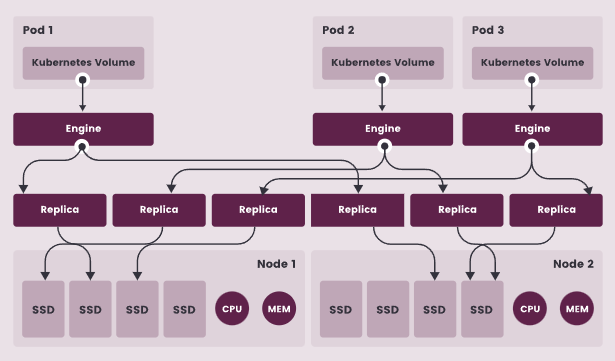In DevOps and cloud-native solutions, managing persistent data effectively is akin to finding a compass in the vast ocean of ephemeral container deployments. Longhorn, an open-source project spearheaded by Rancher Labs, emerges as a beacon of high availability and durability, bringing a robust distributed block storage system to the Kubernetes environment.
As a team immersed in the Kubernetes landscape, we at SlickFinch have seen firsthand how Longhorn revolutionizes data management across different nodes within a cluster. This piece aims to demystify Longhorn’s offering, explain its integration with Kubernetes, and provide you with actionable insights and best practices drawn from our own experiences and those of the broader community.

The Importance of Block Storage in Kubernetes
Kubernetes has become the de facto standard for container orchestration, but its stateless nature poses significant challenges for stateful applications that require persistent storage. Persistent Volumes (PVs) are Kubernetes’ answer to this, enabling pods to outlive their ephemeral nature.
Enter Longhorn, which not only provides persistent volumes but does so with a resilience that ensures your data remains accessible even when the inevitable failures occur within a distributed system. With it’s distributed block storage system, each volume is replicated across multiple nodes, safeguarding against data loss and facilitating a resilient cloud-native storage solution.
Stay tuned as we delve deeper into Longhorn’s features, deployment strategies, and the practical applications that render it an indispensable tool for anyone navigating the complexities of modern cloud environments.
Features of Longhorn
Navigating the ever-evolving terrain of containerized applications, Longhorn stands out with its feature-rich platform that empowers developers and system administrators alike.
High Availability and Reliability
In a Kubernetes cluster, the longevity and accessibility of data can never be left to chance. Longhorn addresses this with a design tailored for high availability. By replicating volumes across multiple storage nodes, Longhorn ensures that a failure in one part of the system doesn’t spell disaster for your data. This replication mechanism is akin to a safety net, catching your data should a component falter, and is a cornerstone of reliable storage in the Kubernetes landscape.
Disaster Recovery and Backup Features
Preparedness is the bedrock of any robust storage solution. Longhorn extends its capabilities with integral backup features that allow for regular snapshots and backups of your volumes to secondary storage, safeguarding against catastrophic events. This attention to disaster recovery is what makes it not just a storage option, but a comprehensive storage platform.
Management of Persistent Storage Volumes
The command center of Longhorn is its intuitive graphical user interface (Longhorn UI), which simplifies the complexities involved in the management of persistent storage volumes. From this control panel, you can orchestrate volumes with a single click, monitor the health of replicas, and even resolve a failed pod without breaking a sweat.
Deployment and Operation
Deploying in a cluster is a masterclass in simplicity. With a few commands, you can initiate the Longhorn manager, which takes charge of orchestrating and maintaining the state of your storage system within the Kubernetes environment.
Deploying Longhorn in a Kubernetes Cluster
Deploying on your cluster is as straightforward as any Kubernetes deployment can get. Using the Longhorn YAML file, you can set up the storage system within minutes. The default storage class will be replaced with Longhorn, and just like that, your applications will be empowered with persistent, replicable storage.

The Longhorn UI and User Experience
Once deployed, the UI provides a user-friendly and intuitive graphical user interface that makes managing storage as easy as managing any other resource in Kubernetes. From provisioning persistent volumes to recovering from backups, the UI is a powerful ally in the management of storage volumes.
Handling Stateful Workloads and Applications
Stateful workloads are the bread and butter of many production systems, and Longhorn excels in supporting these applications. Whether it’s a database or a content management system, Longhorn maintains data consistency and availability through persistent volume claims and Longhorn replicas, ensuring your stateful applications are robust and resilient.
Longhorn Under the Hood
Understanding the technical foundations of Longhorn provides a clear perspective on its resilience and efficiency in a Kubernetes environment.
Longhorn’s Architecture
At its core, Longhorn is a distributed block storage system that’s designed with a microservices approach. It breaks down into three main components: the Control Plane, the Data Plane, and the Longhorn Engine. The Control Plane is responsible for managing the cluster-wide operations such as volume creation, scheduling, and maintenance. The Data Plane, on the other hand, handles the actual data storage and replication across the storage nodes. And finally, the Longhorn Engine, a lightweight, reliable orchestration component, manages the volume replicas and ensures data consistency.
Control and Data Plane Mechanics
Each persistent data volume in Longhorn is treated as an individual unit of management. This modularity allows for operations to be performed on a specific node without affecting the entire system. Furthermore, its sophisticated scheduling algorithm ensures that the replicas of a volume are distributed across different nodes to maximize data availability and fault tolerance.
Use Cases and Best Practices
Longhorn isn’t just a piece of technology; it’s a solution that adapts to various use cases, ensuring that your Kubernetes workloads are always supported by a robust storage backend.
Real-world Applications
We’ve seen Longhorn deployed across a range of scenarios, from supporting databases that require consistent storage to serving as the backbone for cloud-native applications that need to scale dynamically. In one instance, a media company utilized Longhorn to manage the storage for their video processing service, taking advantage of Longhorn’s snapshot and backup features to handle large volumes of data without interruption.
Best Practices for Maximizing Efficiency
To get the most out of Longhorn, it’s essential to follow best practices. These include:
- Ensuring your Kubernetes cluster is set up with high availability in mind, with enough nodes to support the replication strategy of Longhorn.
- Regularly testing backup and disaster recovery procedures to guarantee that you can recover your data when needed.
- Keeping an eye on the performance metrics provided by Longhorn’s UI to preemptively address any potential bottlenecks or issues.
Longhorn’s Ecosystem
Longhorn’s prowess is amplified by its open-source nature and its integration with other cloud-native tools.
Open-Source Contributions and Community
Being an open-source project under the Cloud Native Computing Foundation (CNCF), Longhorn thrives on community contributions. The transparent development process allows users to participate in the growth of the project, enhancing Longhorn with new features and capabilities that serve a wide range of use cases.
Integration with Other Cloud-Native Tools
Longhorn seamlessly integrates with other tools in the Kubernetes ecosystem, like Prometheus for monitoring and Grafana for data visualization. This interoperability is a testament to Longhorn’s design philosophy, which emphasizes complementing and extending the Kubernetes ecosystem, rather than operating in isolation.
Troubleshooting Common Challenges
No system is immune to issues, and Longhorn is no exception. However, the community and documentation provide extensive resources to tackle any known issues.
Known Issues and Resolutions
Occasionally, you might encounter a problem such as a failed pod or a specific node issue. Longhorn’s community forums and GitHub issues tracker are invaluable resources for finding solutions. Moreover, the Longhorn authors and maintainers are proactive in addressing problems and releasing updates that mitigate these challenges.
Support Resources and Documentation
The comprehensive documentation, which includes the Longhorn YAML file technical details and operational guides, is an excellent starting point for both troubleshooting and learning best practices. Moreover, the active Longhorn Slack channel is a hub for real-time advice and support from experts and community members.
The Future of Longhorn and Kubernetes Storage
Looking ahead, Longhorn is poised to continue its trajectory as a leading solution for persistent storage in Kubernetes.
Upcoming Features and Roadmap
The Longhorn project is continuously evolving, with a roadmap that promises enhancements in areas like performance tuning, security, and integration with advanced Kubernetes features. This forward-thinking approach ensures Longhorn will remain relevant and beneficial for modern, cloud-native applications.
The Evolution of Container Management in Production
As Kubernetes solidifies its role in the production environment, storage solutions like Longhorn will become even more critical. The project’s commitment to incremental snapshots, bare metal performance, and persistent volume support signifies its readiness to support the next generation of container management.
Conclusion
The Impact of Longhorn on DevOps and Cloud Architecture
In conclusion, Longhorn stands as a testament to the ingenuity inherent in the open-source community, providing a distributed block storage system that’s both powerful and accessible. For those of us in the trenches of DevOps and cloud architecture, Longhorn offers the promise of data resilience, operational simplicity, and seamless integration with the wider Kubernetes ecosystem. As we harness its potential, Longhorn will undoubtedly continue to shape the landscape of cloud-native storage, driving innovation and stability in an otherwise unpredictable digital world.




